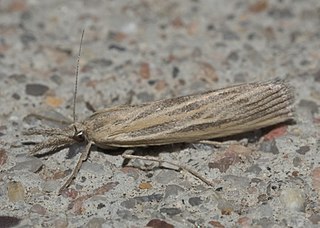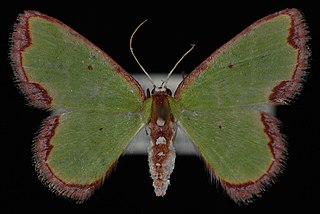
Augustus Radcliffe Grote was a British entomologist who described over 1,000 species of butterflies and moths. He is best known for his work on North American Noctuidae. A number of species were named after him, including the moth Horama grotei.

Thaumatopsis is a genus of moths of the family Crambidae.
Afotella is a monotypic moth genus of the family Noctuidae erected by William Barnes and Foster Hendrickson Benjamin in 1926. Its only species, Afotella cylindrica, was first described by Augustus Radcliffe Grote in 1880. It is found in western North America from Saskatchewan and Alberta south to California.
Sympistis chorda is a moth of the family Noctuidae first described by Augustus Radcliffe Grote in 1880. It is found in North America from British Columbia, south to California. It was formerly known as Oncocnemis chorda, but was transferred to the genus Sympistis in 2008.
Idia scobialis, the smoky idia, is a litter moth of the family Erebidae. The species was first described by Augustus Radcliffe Grote in 1880. It is found in North America from Michigan, southern Quebec and Maine, south to Florida and at least Kentucky.

Synchlora cupedinaria is a moth in the family Geometridae first described by Augustus Radcliffe Grote in 1880. It is found in Florida, the Bahamas, the Virgin Islands, Guadeloupe, Martinique and possibly St. Kitts and Puerto Rico.

Leucanopsis longa, the long-streaked tussock moth or long-streaked halisidota, is a moth of the family Erebidae. It was described by Augustus Radcliffe Grote in 1880. It is found from North Carolina to Florida and west along the coast to eastern Texas. The habitat consists of marshes and wet sedge meadows.
Agriphila anceps is a moth in the family Crambidae. It was described by Augustus Radcliffe Grote in 1880. It is found in North America, where it has been recorded from California.
Agriphila attenuata is a moth in the family Crambidae. It was described by Augustus Radcliffe Grote in 1880. It is found in North America, where it has been recorded from coastal California, Washington, Wyoming, British Columbia and Alberta. The habitat consists of grasslands.
Crambus occidentalis is a moth in the family Crambidae. It was described by Augustus Radcliffe Grote in 1880. It is found in North America, where it has been recorded from Alberta and California.
Pediasia laciniella is a moth in the family Crambidae. It was described by Augustus Radcliffe Grote in 1880. It is found in North America, where it has been recorded from Alberta, California, Illinois, Maine, Michigan, Quebec and Virginia.
Thaumatopsis atomosella is a moth in the family Crambidae. It was described by William D. Kearfott in 1908. It is found in the US states of Arizona and California.
Thaumatopsis bolterellus is a moth in the family Crambidae. It was described by Charles H. Fernald in 1887. It is found in North America, where it has been recorded from New Mexico and Texas.
Thaumatopsis crenulatella is a moth in the family Crambidae. It was described by William D. Kearfott in 1908. It is found in the US states of Arizona, California, Colorado and Nevada.
Thaumatopsis edonis is a moth in the family Crambidae. It was described by Augustus Radcliffe Grote in 1880. It is found in North America, where it has been recorded from Florida, Kentucky, Maine, Massachusetts, Mississippi, Missouri, Nebraska, New Jersey, Oklahoma and South Carolina. It is listed as threatened in the US state of Connecticut.
Thaumatopsis fernaldella is a moth in the family Crambidae. It was described by William D. Kearfott in 1905. It is found in North America, where it has been recorded from Alberta, California, Florida, Maryland, Mississippi, Nevada, New Mexico, Oklahoma, Saskatchewan and Texas. The habitat consists of prairies.
Thaumatopsis fieldella is a moth in the family Crambidae. It was described by William Barnes and James Halliday McDunnough in 1912. It is found in North America, where it has been recorded from California.
Thaumatopsis floridella, the Floridian grass-veneer, is a moth in the family Crambidae. It was described by William Barnes and James Halliday McDunnough in 1913. It is found in North America, where it has been recorded from coastal areas in Florida, Georgia, Mississippi, South Carolina and North Carolina, New Jersey, New York, and Rhode Island. It is also found in Cuba.
Thaumatopsis magnificus is a moth in the family Crambidae. It was described by Charles H. Fernald in 1891. It is found in North America, where it has been recorded from New Mexico, Arizona and Colorado.
Evergestis simulatilis is a moth in the family Crambidae. It was described by Augustus Radcliffe Grote in 1880. It is found in North America, where it has been recorded from Alberta, Arizona, British Columbia, California, Colorado, Montana, Nevada and New Mexico.




